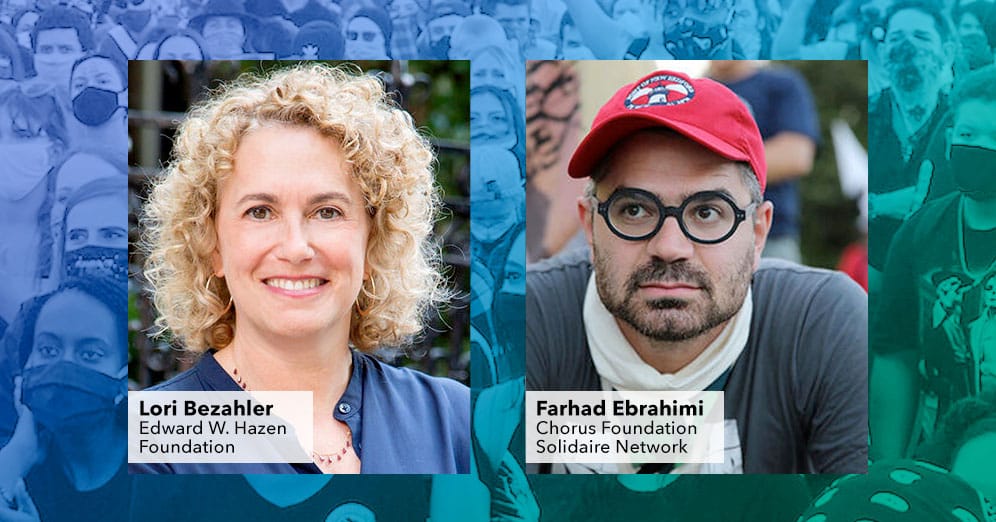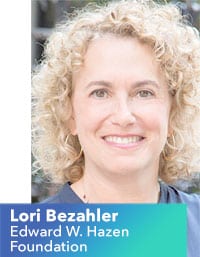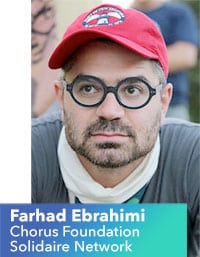“Going All In”: How Some Funders are Spending Down to Lift Movements Up

Most philanthropic organizations are designed, either explicitly or implicitly, to exist forever: so long as they don’t grant more than the returns their endowments provide, they can continue indefinitely. Given such stability, what makes a foundation choose to spend down, giving away the entirety of its assets? What are the effects of such a move on its peers, its grantees, and the larger world it was founded to improve?
By looking at foundations that decided to spend down, funders of all stripes can learn important lessons about the nature of grantmaking, trust, and the funder-grantee dynamic.
In this issue, we interviewed Lori Bezahler and Farhad Ebrahimi, two grantmakers who oversaw their organization spending down — or as one of Bezahler’s grantees put it, “going all in.”
Lori Bezahler is the former President of the Edward W. Hazen Foundation. Farhad Ebrahimi is the founder and former president of the Chorus Foundation.
(To dig further into this topic, check out Stanford Social Innovation Review’s Philanthropy and Power supplement, sponsored by the Chorus Foundation.)
Philos: How did your foundation reach the decision to spend down?
 Lori Bezahler: The Edward W. Hazen Foundation was founded in 1925, but the foundation transitioned to being an independent board fairly quickly, as no Hazen family members joined the board after its founders. From early on, the foundation was doing things that are considered best practices now, but at the time were cutting edge. They put in place board term limits, for example. Historically, there’d always been a focus on race and equity. In the 2000s, there was a shift to name race in the mission explicitly for the first time, and Sharon King, who was president of the foundation before she went to the Heron Foundation, started the push toward parent and youth community organizing approaches that became our signature philanthropic work.
Lori Bezahler: The Edward W. Hazen Foundation was founded in 1925, but the foundation transitioned to being an independent board fairly quickly, as no Hazen family members joined the board after its founders. From early on, the foundation was doing things that are considered best practices now, but at the time were cutting edge. They put in place board term limits, for example. Historically, there’d always been a focus on race and equity. In the 2000s, there was a shift to name race in the mission explicitly for the first time, and Sharon King, who was president of the foundation before she went to the Heron Foundation, started the push toward parent and youth community organizing approaches that became our signature philanthropic work.
Hazen was a comparatively small institution: small staff, small budget. The grantees were very grassroots organizations, and us being a small organization ourselves enabled us to work with them in a different way than a large institution.
After the 2016 presidential election, the grassroots organizations that the Hazen Foundation supported faced both huge trauma and huge opportunity.
The young people and parents were all directly affected by what was being moved into place in the leadership in this country. We would go to meetings with grantees and have them say things like, “When I go to school, I don’t know if my parents are going to be there when I come home, or if there will be an ICE raid while I’m in class.”
On the opportunity side, there were mass protests and people getting politicized, many for the first time in their lives. So how do we get the resources to seize that opportunity and use it to the benefit of movements for racial justice?
I came to the board soon after and told them that things were not business as usual. Is it still okay for us to continue as we had, paying out 6% per year from our endowment? Should we assume the perpetuity of Hazen is somehow primary? Or should we be asking ourselves whether we need to take steps that put this institution at risk in the way that these individuals and grantees are at risk? They’re experiencing personal, bodily, and emotional risk, and meanwhile we’re checking boxes and doing math to figure out how much we’re going to spend. That felt inadequate if we considered ourselves to be their partners, that we had their backs.
That led to two years of intense discussion — a lot of emotion, far more than I had anticipated — and a lot of looking at every possible alternative, because turning out the lights on a nearly 100-year-old institution is no small thing. The board at this point was comprised of people who are in movement work in different ways, so they wanted to take their role quite seriously as a representative of the work and the life they had outside of Hazen.
So two years later, by consensus agreement of the board, the board elected to spend down. One of our grantees said we should describe it as “going all in” instead, to give it a more positive sound. So we went all in for racial justice. And within two weeks of the decision, I called every one of our grantees to let them know.
I told them that beyond the decision itself, we didn’t yet know what it would mean in terms of the foundation’s activities. At that point we had about 25 million dollars in assets. We’d continue the focus on education justice and youth organizing, but in terms of how and who we’d fund? That had yet to be created, and we knew we’d need our grantees’ help in that.
We took their advice on everything, and the grantmaking was all multi-year, general operating support through the end.
 Farhad Ebrahimi: The Chorus Foundation was a private foundation created in 2006 as a vehicle to fully redistribute all my wealth in my lifetime, so the spend down was here from the start. From 2006 through 2023, Chorus supported communities on the frontlines of the extractive fossil fuel economy as we worked together for a just transition to a fair and sustainable new economy.
Farhad Ebrahimi: The Chorus Foundation was a private foundation created in 2006 as a vehicle to fully redistribute all my wealth in my lifetime, so the spend down was here from the start. From 2006 through 2023, Chorus supported communities on the frontlines of the extractive fossil fuel economy as we worked together for a just transition to a fair and sustainable new economy.
If trust-based philanthropy and holding power accountably is about building the relationships and trust to experiment with community-centered decision making, then it must also be about building the capacity, confidence, and infrastructure to hand this financial infrastructure over to the communities themselves. There are lots of ways to do that. One way is for a foundation to spend down while building up its grantees alongside community-owned and -controlled financial infrastructure.
The Chorus Foundation explored this line of inquiry in four different geographies: Eastern Kentucky, which was our first focus area; Alaska; Buffalo, New York; and Richmond, California. Through our long-term, unrestricted funding commitments to anchor organizations in each community — and through additional funding for other organizations and projects in each region — Chorus supported a variety of activities aimed at building local power and leadership. As you can imagine, we received, explored, and arrived at different answers, so our spend down looked different for each of our grantees and each of our regions.
Philos: What did the final phase of grantmaking look like, and how did that impact your grantees?
Lori Bezahler: One thing that distinguished this phase is that there was no deadline for the grantee to spend the grant funds. Grantees could put it all in the bank, or none in the bank. They could buy property with it. They could use it however they wanted.
One focus for grantees was to enhance their fundraising. That led us to do capacity work in our final years. For example, we created opt-in peer cohort groups around key issues, like financial sustainability, human resources, communications, and leadership development. Each cohort group had a budget and free rein to spend that. Some had a consultant do group trainings and some made funds available for members to hire help directly.
We continued to have a pot of money available for coaching that we parked with a fundraising consultant who would then have hours available to each group for assistance.
In the first year of this process, we had a five-year horizon. In the first year, we gave four-year grants. We didn’t plan out grants for the fifth year because we didn’t know what was going to happen with our endowment over that time frame. We wanted to maximize the amount we could do in four years and then make up for it in the fifth year. It turned out that we did pretty well. First, we pulled entirely out of the equities market, and then more slowly worked our way out of the bond market to create more stability. We had a great treasurer who figured out a lot of these details.
If the focus of our work is to support young people and parents who are challenging racism, white supremacy, and patriarchy, then how could we continue to operate in ways that simply reify those systems? We made the commitment to be as rigorous as we could in considering not just the what, but the how of our practice. For me, the deepest confirmation was feedback we got from the field, that they felt us doing that work. They saw it in our actions and the way that we communicated that to our peers resonated with them. That’s not to say that we didn’t make mistakes, and not to say that grantees didn’t see that we were making mistakes, but we were fostering relationships in which they could tell us when we made mistakes.
Farhad Ebrahimi: If we think of capital as being either consumptive or productive in nature, then particularly in the advocacy world we can see most grants get consumed: they go toward recurring costs, like staff salaries. A productive use of capital would be something like buying a building, or land, or some means of production. Sometimes groups don’t have a choice, if their funder puts constraints on how or when funding can be spent. But organizations can use both consumptive and productive capital to start to build and shift local economic power to make them less dependent on outside private capital — folks like us.
So our main priority for the spend-down was to help our grantees be in better shape with respect to the constant need for movement nonprofits to fundraise from private philanthropy. There are a few ways that can happen.
The most beautiful way is that those communities build their own economic power, but I think another way is: did our spend down help our grantees have an easier time fundraising from our peers in philanthropy? Our grantees have repeatedly told us over the years that Chorus being the first to fund them meant they could pique the interest of other funders, or that our unrestricted grants allowed them to do something interesting that drew in new funders. Such an outcome is wonderful, but it also should absolutely be the ground floor for a funder that spends down. The bigger question remains to be answered: did our support allow our grantees to do the kind of work that births a new world where philanthropy is not critical to their mission?
When we approached folks in all four of our geographies with democratizing decision making around philanthropic resources, people had different answers in different places, and usually the answer was iterative and emergent.
We offered to continue their funding at the same level for the next ten years. But we also told them, “if you want us to simply give you ten years’ worth of money at once and you can do whatever you want with it, we can do that instead.”
A lot of grassroots organizations opted for the former, telling us that they wanted us to be a good funder for at least long enough for them to figure out if they want to play that role in governing a lump sum of capital. For example, in Richmond, about midway through our ten-year commitment, they said that they were ready to shift to controlling that capital. Over the previous years leading up, as we incrementally gave them more control in the governance of grant making in Richmond, they felt more confident to fully take over.
This process also took place within an ecosystem of grantees in these areas who worked together complementarily. Key to our strategy was not just funding the growth of political power, but economic and cultural power too. We would fund not only Kentuckians for the Commonwealth, a multi-issue progressive base building organization, but also Mountain Association, which is doing the capital-intensive work of building a post-fossil fuel economy in the region. And we funded the STAY Project, a youth organization that provides support to queer and gender non-conforming young people in the coal fields of Appalachia. Some funders would scratch their heads and ask, “how is that about the climate?” And we’d reply: “if we care about the future of Central Appalachia, we don’t want the best young people to leave because they’re not being supported for who they are.”
Philos: What can funders learn from your experience and from other peers who are spending down?
Lori Bezahler: I don’t proselytize for spending down. I think that there are some very good arguments around reparations and how capital has been amassed, and those resonate for some institutions, but many are a long, long way from choosing to spend down. Expecting an institution to do so that isn’t ready to have that conversation can undermine progress in some ways, but I do think that intentional spending policies are critical — and are not the norm in philanthropy. It’s so easy to think that a five percent drawdown in perpetuity is just the way to run a foundation. That’s how they’ve done it for a hundred years.
One way to start to push back on that is for boards to have, as part of their strategic planning cycle, an affirmative decision around spending: somewhere between five percent and spending down. Now, some institutions have in their founding documents that they’re established in perpetuity, which is a problem, but there can sometimes be workarounds.
In the larger picture, a lot of people foresaw the funding cliff after 2020. Philanthropy does not have an eye for sustainability. But because Hazen made larger grants at the end, we aimed to set organizations up to be more sustainable. In the last year we especially focused on organizations that tended to be smaller, the ones with less than a million-dollar budget, and we were explicit with our larger grantees about why.
Funders need to think critically about sustainability and change how they fund, or how they can support beyond funding. Organizing within philanthropy is important, too. There aren’t many entities that can hold philanthropy accountable, so some level of peer pressure is critical.
Farhad Ebrahimi: I’ve landed on a stance of abolition toward private philanthropy. Trying to wrestle with the questions of “good” versus “bad” philanthropy can distract from fundamental questions of power: who owns and controls. And we can too easily fixate on the role of the donor or the grantmaking professional, even though we’re essentially an obstacle between the grantee and the thing that they need. I’m an abolitionist, but I don’t believe there’s a switch hidden somewhere that says “abolition,” and if you flip it the bad thing, whether it’s policing or prisons or private philanthropy, just goes away. We need to navigate the contradictions of working with it while at the same time dismantling it and aspiring for a future where it no longer exists.
I think for private philanthropy, it makes sense to start with something like trust-based philanthropy and holding power accountably, but it’s only useful in as much as you build the relationships and infrastructure to share power equitably and democratize these private philanthropic institutions. And there are so many avenues, like participatory grantmaking, or altering board governance, or putting community members on the board. But for me, those are all just steppingstones, because the institution is what stands in between the communities and the thing that’s been extracted from them — their own wealth and power that could be used for community self-determination.
I’d encourage those who work in philanthropy to pick up the mantle of organizing as much as grassroots groups are. Organize among your co-workers in philanthropy. One thing I’ve learned is that education on these issues isn’t enough. Trainings aren’t enough. Because what invariably happens is people go through a training, and then go to their respective workplace and think, “well, I know what we ought to be doing now, but I still don’t know how to get the board to do it.”
Of course this isn’t a new insight, people have been organizing within philanthropy long before I arrived, but what would be new is for us to have a level of intentionality, infrastructure, and shared frameworks and shared language to train people to do so. It’s one of the reasons I’m on staff at Solidaire now. A core mission of Solidaire since we founded it is to build out infrastructure to support our donor members to become better organizers in the sector.

